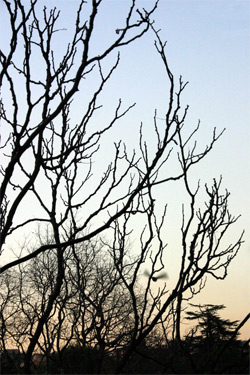Driving alone on a highway through the desert of the Southwest, I passed a sign announcing the “Last Services for 100 Miles.” I asked myself, “How did they get a minyan way out here?” And then I came to a gas station. In the desert, “Last Gas” signs were powerful magnets, pulling my car off the road. A “Last Chance” sign on a roadside farm market has the same effect.
“Last Peaches of the Season”? I’m pulling over. “First Asparagus”? I’m there, too.
It’s no wonder that I consider first fruits of the season to be significant. I grew up saying — and continue to say — the Shecheheyahu on the occasion of eating a seasonal fruit or vegetable for the first time in a year. The Shecheheyahu gives thanks to G-d “who has granted us life, sustained us, and enabled us to reach this occasion.”
We know for sure when we enjoy a seasonal fruit or vegetable for the first time, but we never know which taste will be the year’s last. And that, I believe, may be one of the unconscious motives of the leaf peepers who hunt for the glorious color of deciduous trees. It’s another aspect of carpe diem.
•
One fall day I drove to see an aunt who had been diagnosed with cancer. Luminous with sunlight, yellow leaves drifted from the trees so slowly that they looked as though they were hovering above the road. I felt as if I traveled through suspended golden leaves for an eternity, but it was probably only a few minutes. As I drove, I thought about how my aunt was well enough to revel in that autumn, but I wondered how many more she would have. I was too young then to know enough to ask that question about myself.
Now I’m well past having A.E. Housman’s “fifty Springs” to look at blossoms. I’ve taken his advice, however, and I’ve grown to love the shapes of branches against the sky — with and without snow or bloom. Seen across a field, the dark outline of a row of trees against the glowing sky of a winter sunset has a stark beauty; as the sky changes from a soft gold to a glowing blue, the calligraphy of the branches is as evocative of evanescence as any flight of petals in the wind.
Bare of leaves, old sycamores with their white branches and upper trunk — given a sunny winter’s day — are, to use a decorator’s word, stunning. A sycamore in winter is a match for even a well-established weeping cherry in full bloom.
When I drove North this year to look at fall colors, some trees stood like silver-gray sentinels among those still clad with bronze and russet. Now some trees have but a few curling leaves left; against the sky they’re ochre embroidered lace. Autumn’s a slow disrobing of the trees, a tantalizing strip to reveal their unadorned shape.
When the buds begin to open, most years I find myself a bit melancholy because it feels to me as though the trees will be hidden. I’m afraid I’ll forget what they look like without their leaves—like forgetting the face of an old friend now gone.
Is russet a fall color? Fashion says so: It’s a favorite in fall lines of clothing and I see it alongside the bronze and gold leaves, to be sure. But then in late winter the buds begin to swell, and in early spring a russet haze appears on trees seen from a distance. For me the true color of spring is that first blush. Only later in the season do we find the greens and golds, the whites and pinks with which spring is more often associated.
In spite of all my professed love of bare branches, I want to see the trees in flower again. Along the city streets, the most noticeable blooms in early spring are the white of the Bradford pear and the pink of the cherry.
In the summer, when so much else is in flower, I don’t think much about the Bradford pears and cherry trees that line the streets. They aren’t assertive.
But after the first cold spell in November, I begin to watch for unseasonable blossoms. Usually I am in a moving vehicle when I pass one of these blooming trees. If I’m with someone, by the time I can point it out, we’re too far away for anyone else to see it. Sometimes it’s a trick of a streetlight, making leaves look like blossoms. It’s almost as though I want so much to see the flowers that I do. Is it a trick of vision? Do I have an imaginary spring friend?
But when I’ve been on foot, I’ve sidled up to one of the blooming trees to take a closer look. Just the other day, I thought I saw pink on a cherry tree, and I found a couple of buds and one flower opening on the end of a branch. I can get to — and reach — some of these trees that have, over the last few years, been winter bloomers.
On most trees only a few blossoms open in winter months. Once, however, I saw a city cherry tree in full bloom. I thought it was a goner, but when spring arrived, the tree bloomed again.
How can it be that a tree blooms in winter? The roots of the winter-blossoming trees might be near an underground pipe that’s warming the soil. For whatever reason, some trees can be counted upon to offer a flowering twig or two throughout the winter.
My stopping to look at winter bloom is part of the same impulse that pulls me to the farm stand with its hand-painted placard announcing variations on “First of the Season” and “Last Chance.” I choose not to ask the real question—are these blossoms the first, or are they the last? • 10 November 2010




